The science of taste
By JOE O'CONNELL, cbbqa Past President
First posted August 24, 2001
Modified by BILL WIGHT, cbbqa member
Updated December 10, 2002
Taste in humans is the brain's
detection of a stimuli, which the brain interprets as the basic
tastes: salty, sour, sweet, bitter and, possibly, umami.
(The latter, fifth taste is still under investigation and appears to
relate the the glutamate found, for example, in MSG.)
Each of these five "basic tastes" are registered via a
series of chemical reactions in the taste cells of the taste buds.
Five separate biochemical pathways underlie each of these five basic
tastes. Each taste cell (usually called "taste buds")
detect all five basic tastes, so that individual taste cells are not
programmed, or "tuned," to respond to only one kind of taste
stimulus.
Salty
As described in Scientific American, salts, such as sodium chloride (NaCl),
trigger taste cells when sodium ions (Na+) enter through ion channels on
microvilli at the cell's apical, or top, surface. (Sodium ions can
also enter via channels on the cell's basolateral, or side, surface.)
The accumulation of sodium ions causes an electrochemical change
called depolarization that results in calcium ions (Ca++) entering the
cell. The calcium, in turn, prompts the cell to release chemical
signals called neurotransmitters from packets known as vesicles.
Nerve cells, or neurons, receive the message and convey a signal to the
brain. Taste cells repolarize, or "reset," themselves in
part by opening potassium ion channels so that potassium ions (K+) can
exit. Id.
Here is an illustration, curtsey of Scientific American
Magazine
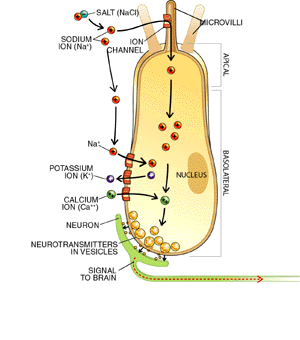
Sour
What the human tongue perceives as "sour" is actually the
perception of "acidic". As described by Scientific
American, acids taste sour because they generate hydrogen ions (H+) in
solution. Those ions act on a taste cell in three ways: by
directly entering the cell; by blocking potassium ion (K+)
channels on the microvilli; and by binding to and opening channels
on the microvilli that allow other positive ions to enter the
cell. The resulting accumulation of positive charges depolarizes
the cell and leads to neurotransmitter release. Id.
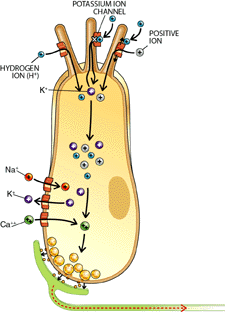
Sweet
Scientific American explains that sweet stimuli, such as sugar or
artificial sweeteners, do not enter taste cells but trigger changes
within the cells. They bind to receptors on a taste cell's surface
that are coupled to molecules named G-proteins. This prompts the
subunits (a, b and
g) of the G-proteins to split into a and bg, which activate
a nearby enzyme. The enzyme then converts a precursor within the
cell into so-called second messengers that close potassium channels
indirectly. Id.
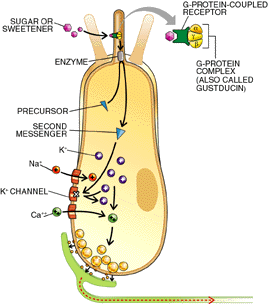
Bitter
The taste that we perceive as bitter, such as quinine and coffee,
results from stimuli that, as Scientific American explains, also act
through G-protein-coupled receptors and second messengers. In this
case, however, the second messengers cause the release of calcium ions
from the endoplasmic reticulum. The resulting buildup of calcium
in the cell leads to depolarization and neurotransmitter release. Id.
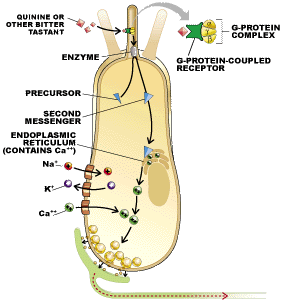
Umami -- the fifth taste
Scientists have recently identified a fifth taste, called Umami.
Amino acids such as glutamate, which stimulates the umami taste,
are known to bind to G-protein-coupled receptors and to activate second
messengers. Scientific American admits, however, that the
intermediate steps between the second messengers and the release of
packets of neurotransmitters are unknown. Id.
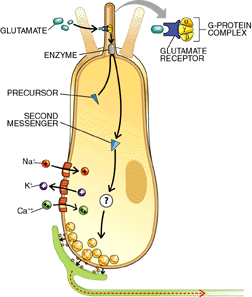
Related sites:
|